Diamonds are available in a variety of differently shaped cuts.
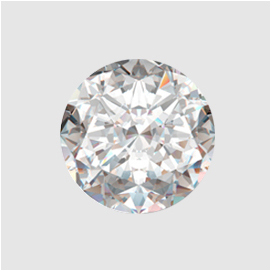
The round brilliant cut diamond is by far the most popular choice worldwide. In 1919 Russian mathematician Tolkowsky calculated the theoretical proportions for this specific cut in such a way that 100% reflection (sparkle) is obtained. All round brilliant diamonds are polished according to these proportions. This classic shape is perfect for a diamond engagement ring or any other piece of jewellery. The round brilliant has been fashionable in the past, is fashionable today and will always be fashionable in the future. It remains a popular first choice.
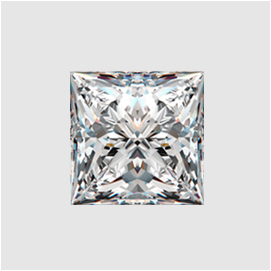
The princess cut is fast becoming one of the most popular fancy shaped diamonds today. The face-up shape of the princess cut is square and its side profile is an inverted pyramid. Its unique shape and pointed corners put it in a different class than other shapes. Its unique, defining look is distinguishable from other shapes.

With its large pavilion in the lower half, the emerald cut shaped diamond has a unique style. Due to the large table it highlights the clarity of the diamond. Its rectangular shape sets it apart from other shapes in such a way that it is easily identifiable with the naked eye.
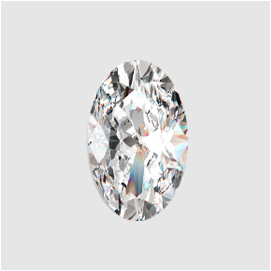
At first sight an oval cut diamond looks quite similar to a round brilliant. However, when looking at it more closely, one can see that it has longer sides and two sharper corners. When considering a ring this shape is excellent for a person who has long, slender fingers.
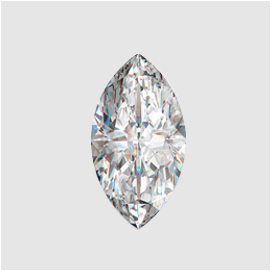
The marquise cut is a traditional shaped diamond which can be described as the "skinny" brother of the oval. This shape brilliance is further enhanced if surrounded by other shaped smaller diamonds. Carat for carat this unique shape has one of the largest crowns (upper half), making it a good choice to maximise the perceived size.
Carat (Ct) is the term given to the weight of a gemstone. Generally speaking the larger (heavier) the diamond, the more expensive it will be, however it is possible to purchase a larger diamond for less than a smaller one, provided a compromise is made with colour, clarity and cut.
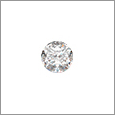
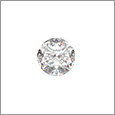
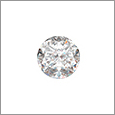

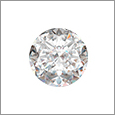




Diamonds come in many different shades of colour. From totally white (D) to fancy yellow, green, pink or blue. Purchasing a diamond that has been certified by the GIA or HRD laboratories guarantees the colour, clarity, carat weight and cut.
Certified diamonds are usually slightly more expensive than non-certified stones. Diamonds as small as 0.25 carat are now available with certificates. Smaller diamonds set in eternity rings etc are not usually certified. Our standard non-certified diamond quality is G colour and VS purity.
When a rough diamond is found it has spent millions of years evolving in the Earth. Nature is rarely perfect and a totally flawless diamond (IF) is a very rare thing. Most diamonds contain small natural imperfections called inclusions. These imperfections are graded and this partly determines a diamonds value. A diamond that has been certified by the GIA or HRD laboratories guarantees the clarity for that stone.
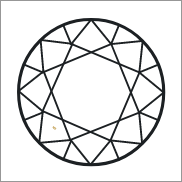
Minute inclusions, which are extremely difficult for a skilled grader to see at 10x magnification.
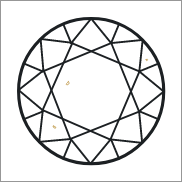
Minute inclusions that are difficult for a skilled grader to see at 10x magnification and are invisible to the naked eye.
The cut refers to the make of the diamond. All brilliant-cut diamonds have 52 facets. Two diamonds of the same weight can look different in size. One might look dull compared to another. This is due to its cut. Certificated diamonds will detail the type of cut and symmetry.
This is the term given to a natural characteristic that occurs in some diamonds.
Under a UV light some diamonds will show a fluorescence.
This can have an influence on a diamonds value.
By blending Colour, Clarity, Cut and Carat a diamond can be chosen to fit any budget. With Diamonds, size is not everything! However, the more money spent, the greater the choice in balancing the carat size and quality of the diamond.
There are two types of stones. Natural Diamonds and Cultured Lab Grown Diamonds. Natural Diamonds take millions of years to naturally grow in the Earth. Lab Grown Diamonds are created in a laboratory using the latest technologies. There is a significant difference between a Natural Diamond and a Lab Grown Diamond's initial and secondhand values. Please ask us for our advice.
The following 10 minute video from GIA further explains the above concepts.
Our jewellery is independently tested and hallmarked by the London or Birmingham Assay Office.
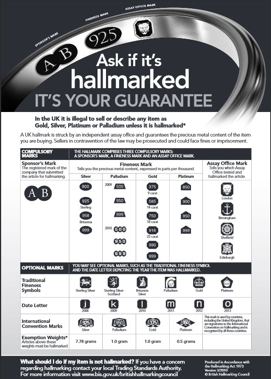
Since the Hallmarking Act of 1974, all our jewellery has been independently hallmarked by the British Hallmarking Council. This gives you the purchaser a guarantee of the quality and type of precious metal in our jewellery. All our jewellery carries our own Sponsors mark, Assay Office mark, Date mark, Common Control Mark and Metal Fineness mark.
Make sure before you buy jewellery that it has a proper independent hallmark like ours, otherwise you may not be buying what you think it is.
Our Cultured Lab Grown Diamonds are considered to be Ethically and Environmentally friendly. However their resale value is far less than a Natural Diamond. A decision has to be made between buying a stone that maybe larger, whiter and cleaner than its Natural equivalent, but is almost worthless secondhand.
Our Cultured Diamonds will be invoiced as Lab Grown Diamonds.
| UK | Continental | USA | Internal Diameter(mm) | Internal Circumference(mm) | UK | Continental | USA | Internal Diameter(mm) | Internal Circumference(mm) |
|---|---|---|---|---|---|---|---|---|---|
| A | - | 0.25 | 12.03 | 37.83 | A 1/2 | - | 0.50 | 12.22 | 38.42 |
| B | - | 0.75 | 12.41 | 39.02 | B 1/2 | - | 1 | 12.61 | 39.67 |
| C | - | 1.25 | 12.8 | 40.22 | C 1/2 | - | 1.5 | 12.99 | 40.82 |
| D | 1 | 1.75 | 13.18 | 41.42 | D 1/2 | 2 | 2 | 13.37 | 42.02 |
| E | - | 2.25 | 13.56 | 42.61 | E 1/2 | 3 | 2.5 | 13.75 | 43.27 |
| F | 4 | 2.75 | 13.94 | 43.81 | F 1/2 | - | 3 | 14.13 | 44.41 |
| G | 5 | 3.25 | 14.32 | 45.01 | G 1/2 | - | 3.5 | 14.51 | 45.61 |
| H | 6 | 3.75 | 14.7 | 46.2 | H 1/2 | - | 4 | 14.89 | 46.8 |
| I | 7 | 4.25 | 15.08 | 47.4 | I 1/2 | 8 | 4.5 | 15.27 | 48 |
| J | - | 4.75 | 15.46 | 48.6 | J 1/2 | 9 | 5 | 15.65 | 49.2 |
| K | 10 | 5.25 | 15.83 | 49.77 | K 1/2 | - | 5.5 | 16.03 | 50.39 |
| L | 11 | 5.75 | 16.22 | 50.99 | L 1/2 | - | 6 | 16.41 | 51.59 |
| M | 12 | 6.25 | 16.61 | 52.19 | M 1/2 | 13 | 6.5 | 16.8 | 52.79 |
| N | - | 6.75 | 17.01 | 53.47 | N 1/2 | 14 | 7 | 17.21 | 54.1 |
| O | 15 | 7 | 17.42 | 54.74 | O 1/2 | - | 7.25 | 17.62 | 55.38 |
| P | 16 | 7.5 | 17.82 | 56.02 | P 1/2 | - | 7.75 | 18.03 | 56.66 |
| Q | 17 | 8 | 18.23 | 57.3 | Q 1/2 | 18 | 8.25 | 18.43 | 57.96 |
| R | - | 8.5 | 18.64 | 58.57 | R 1/2 | 19 | 8.75 | 18.84 | 59.21 |
| S | 20 | 9 | 19.04 | 59.85 | S 1/2 | - | 9.25 | 19.25 | 60.49 |
| T | 21 | 9.5 | 19.45 | 61.13 | T 1/2 | 22 | 9.75 | 19.65 | 61.77 |
| U | - | 10 | 19.86 | 62.4 | U 1/2 | 23 | 10.25 | 20.06 | 63.04 |
| V | 24 | 10.5 | 20.26 | 63.68 | V 1/2 | - | 10.75 | 20.47 | 64.32 |
| W | 25 | 11 | 20.64 | 64.88 | W 1/2 | - | 11.25 | 20.83 | 65.48 |
| X | 26 | 11.5 | 21.02 | 66.07 | X 1/2 | - | 11.75 | 21.21 | 66.67 |
| Y | - | 12 | 21.41 | 67.27 | Y 1/2 | - | 12.25 | 21.6 | 67.87 |
| Z | - | 12.5 | 21.79 | 68.47 | Z 1/2 | - | 12.75 | 21.99 | 69.09 |
| Birthstones | ||
| Month | Suggested Stone | Colour |
|---|---|---|
| January | Garnet | Dark Red |
| Febuary | Amethyst | Purple |
| March | Aquamarine | Light Blue |
| April | Diamond | White |
| May | Emerald | Bright Green |
| June | Pearl | Cream |
| July | Ruby | Red |
| August | Peridot | Pale Green |
| September | Sapphire | Deep Blue |
| October | Opal | Variegated |
| November | Topaz | Yellow |
| December | Turauiose | Turquoise |
If you have any questions please don't hesitate to get in touch. Our contact details are in the black box below.